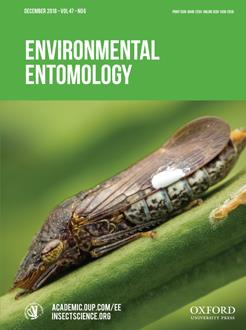Nana Banahene, Salem K. Salem, Trevor M. Faske, Hannah M. Byrne, Madison Glackin, Salvatore J. Agosta, Andrew J. Eckert, Kristine L. Grayson, Lily M. Thompson
Environmental Entomology 47 (6), 1623-1631, (1 October 2018) https://doi.org/10.1093/ee/nvy149
KEYWORDS: Lepidoptera, thermal biology, invasive species, climate change
As global temperatures rise, thermal limits play an increasingly important role in determining the persistence and spread of invasive species. Gypsy moth (Lymantria dispar L. Lepidoptera: Erebidae) in North America provides an ideal system for studying the effect of high temperatures on invasive species performance. Here, we used fluctuating temperature regimes and exposed gypsy moth at specific points in development (first–fourth instar, pupa) to cycles of favorable (22–28°C) or high-temperature treatments (30–36°C, 32–38°C, 34–40°C) for either 2 or 7 d. We measured survival, growth, and prolonged effects of exposure on development time and pupal mass. Survival generally decreased as the experimental temperature treatment and duration of exposure increased for all instars and pupae, with a narrow threshold for lethal effects. In response to increasing temperature and magnified by longer exposure times, growth abruptly declined for third instars and development time increased for pupae. For those surviving the 2-d exposure treatment, development time to pupation increased for all instars, but we did not find consistent effects on final pupal mass. These negative effects of high temperature provide important data on the susceptibility of gypsy moth to heat at different points in development. This work improves our understanding of thermal limits to growth and development in gypsy moth and can aid in determining invasion potential under current and future climates.

